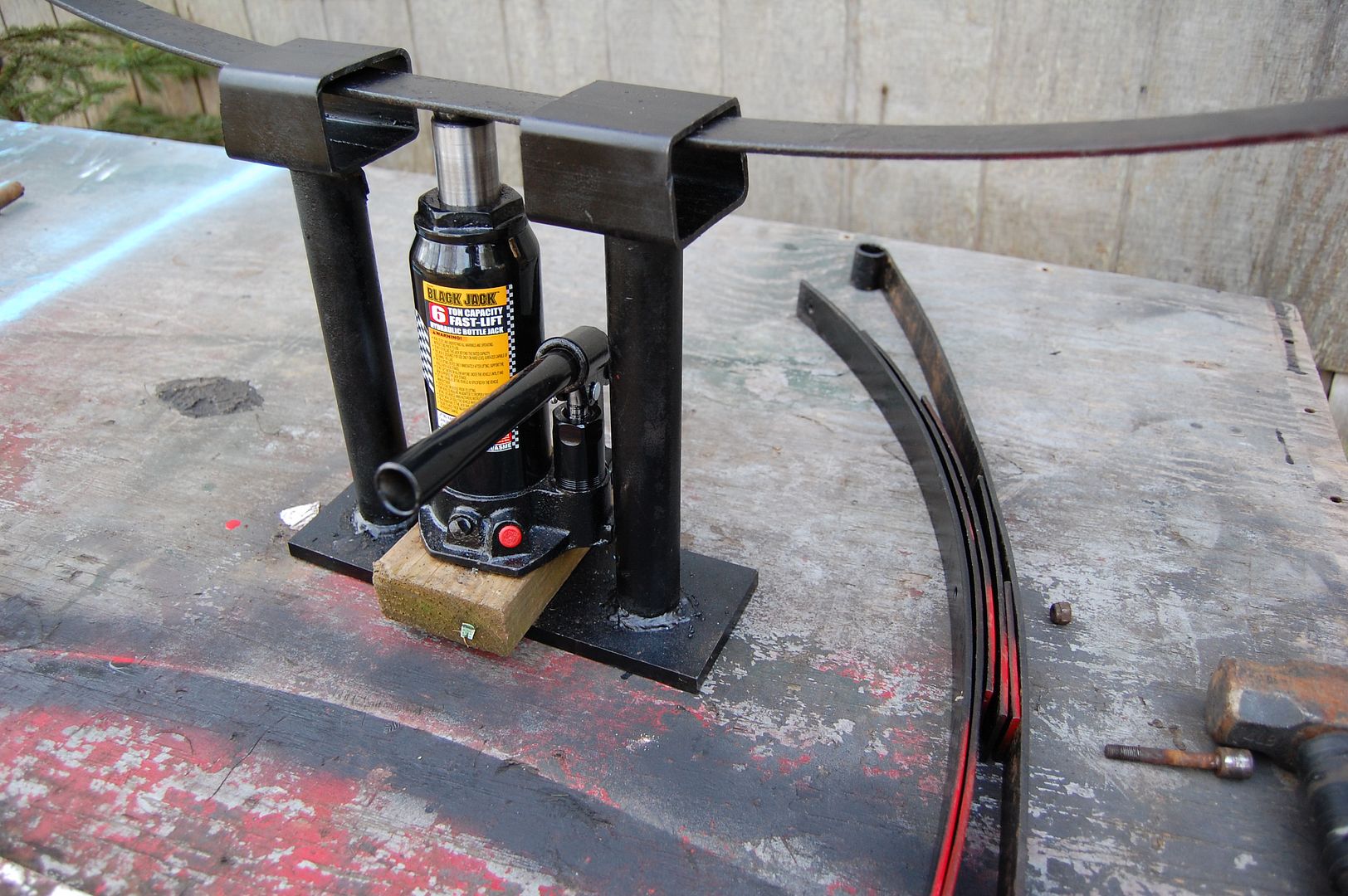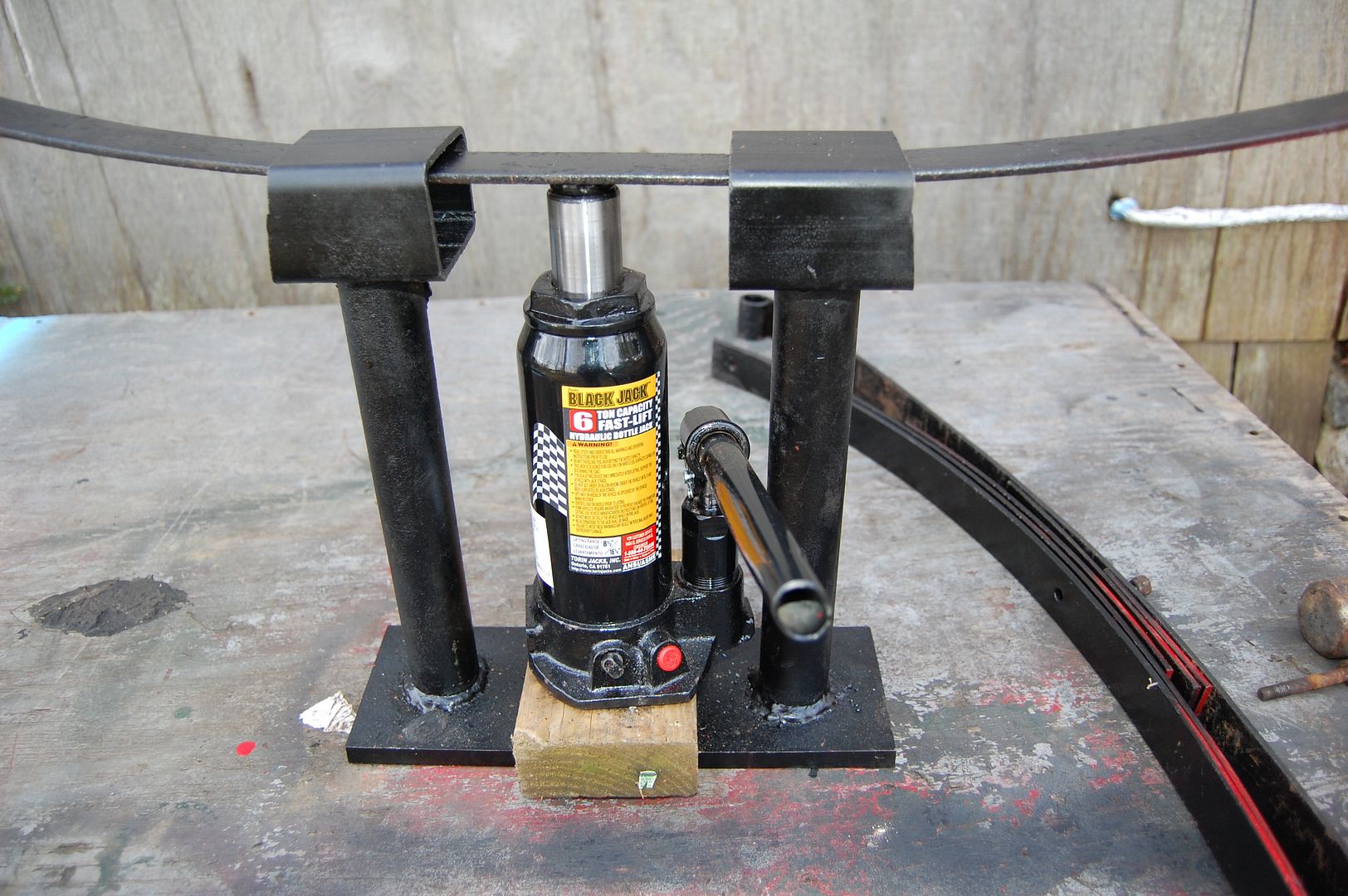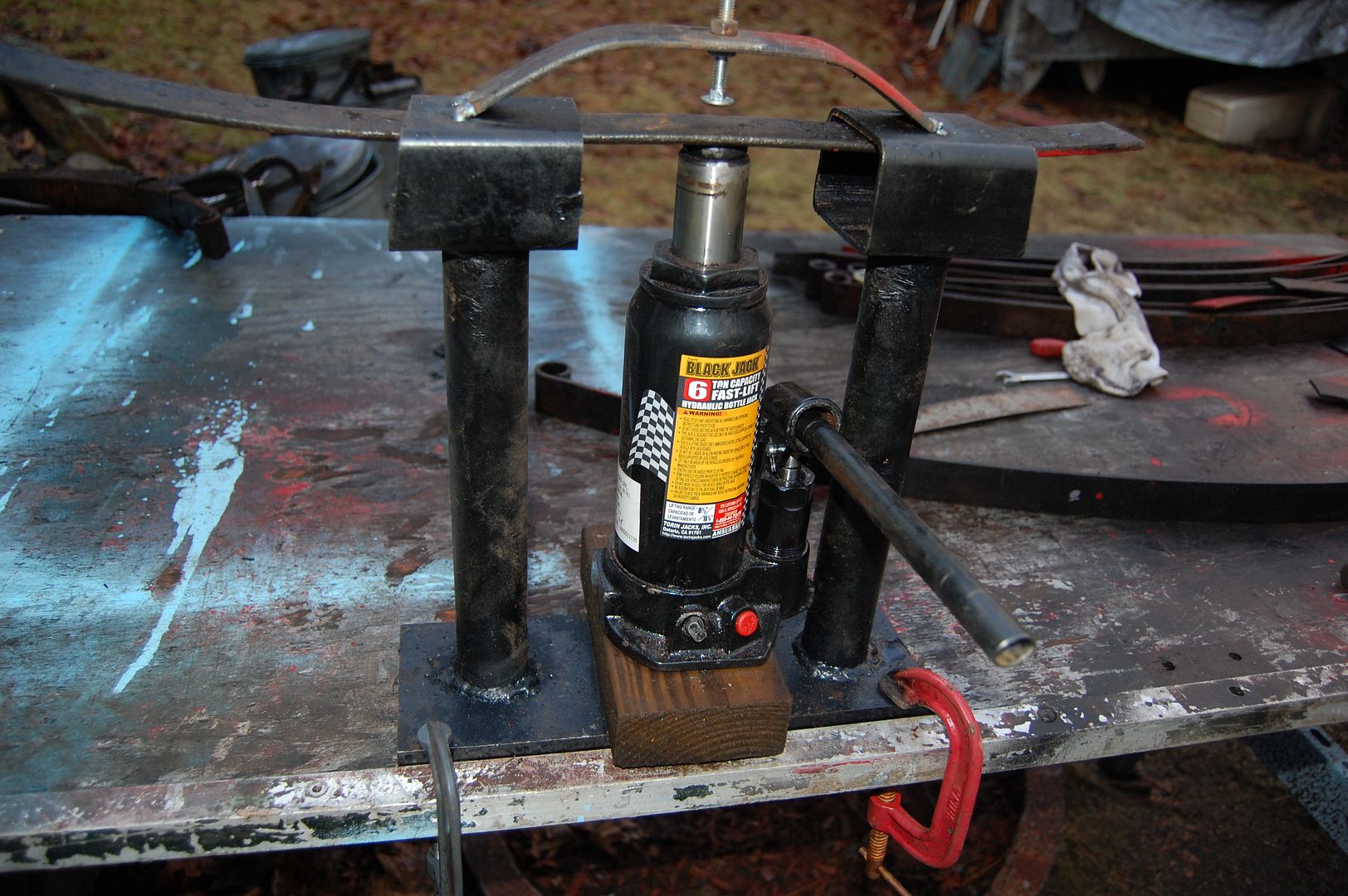
Here's a tool I built a while back (picture below), but just got to use today. It's for re-arcing the leaf springs in several of my cars (Spridget, MGB and A35). A shop press would also work, but I don't have one at home (and don't have the room for one anyway).
When I needed to re-arc the leaf springs in the race-Spridget (to lower it) about 7 or 8 years ago, I used a two pound sledge hammer and "worked" them down cold. This is a time-consuming but perfectly legitimate way to change the arc on leaf springs. I does not change the load bearing of the spring appreciabley. I had read that Roger Williams used this same method with success. He's the Texas guy who started the "Spec-Sprite" class.
The "anvil" I used was an old 1500 Spitfire engine block ("perfect!"  ). I just placed the spring over one of the open bores and hammered the arc back flatter (a little at a time). Once I got all the leafs on one side flattened and put together, I tried them on the car to judge how high the car sat. It took 3 or 4 attempts before I got things decent. Then I used those leafs as a template for the leafs on the other side.
). I just placed the spring over one of the open bores and hammered the arc back flatter (a little at a time). Once I got all the leafs on one side flattened and put together, I tried them on the car to judge how high the car sat. It took 3 or 4 attempts before I got things decent. Then I used those leafs as a template for the leafs on the other side.
Anyway, all that hammering gets old quickly, so I built this little setup to re-arc the leaf springs on the my cars (they all need some adjustment, plus I'm adding a few leafs to the A35). When bending, I stay away from the center hole and just bend back the outer half of each leaf. I mark the spring in 1" increments and bend a little at a time. It's not a quick job, but it's easy to control and it works great.
The bottle jack is a 6 ton unit ($25 at Walmart) and I needed it anyway for my new van. The other stuff is just scrap I had around.


We had a similar setup when we were racing in circles in the mid 70's. I always liked the" tweekability" of running leafs. Even though coils were much easier to work with, once you got leafs right they stayed right.
Cool setup, I'll have to keep that in mind if I ever find myself running a car with a archaic suspension again (I keed, I keed). 
BTW, just noticed it's your birthday, have a good one.
Looks like this would work fine the other way, too. My question is if it's safe to restore sagging springs (that aren't visibly cracked or rusted).
In reply to VanillaSky:
Back when Jeeps had leaf springs this was a popular method to get a couple inches of lift. Seems like they would eventually sag back though.
VanillaSky wrote:
........My question is if it's safe to restore sagging springs (that aren't visibly cracked or rusted).
The springs in my race-Spridget were "cold shaped" about 8 years ago. They haven't changed a bit. Hard to say how this would work with heavier vehicles though.
Marty! Takes a licking and keeps on ticking.... wrote:
......I'll have to keep that in mind if I ever find myself running a car with a archaic suspension again (I keed, I keed).  BTW, just noticed it's your birthday, have a good one.
BTW, just noticed it's your birthday, have a good one.
Haha! 
Yeah, us British car racers wear our archaic suspensions as a Badge of Honour. 
I still feel like a kid......I don't know who the hell that old guy in the mirror is?
I bet if you made a stop across the top, you could bend them pretty consistently, and a bit quicker. I'm very glad you posted this - I've been wondering how this was done.
aeronca65t wrote:
The "anvil" I used was an old 1500 Spitfire engine block ("perfect!"  ). I just placed the spring over one of the open bores and hammered the arc back flatter (a little at a time).
). I just placed the spring over one of the open bores and hammered the arc back flatter (a little at a time).
Wow, you used a Spitfire 1500 block as an anvil?
I sure hope your hammer wasn't damaged.
SkinnyG wrote:
I bet if you made a stop across the top, you could bend them pretty consistently, and a bit quicker.
Great idea!
I was mucking about with a magnetic base and dial indicator to make sure I was bending each leaf spring "just right". But it was tedious and really too "fussy" for this sort of work.
So I've added a simple "stop" (see picture below).
The "stop" is a piece of flat steel that is bent so that it bridges across each side of the fixture. It's welded into postion. It has a long bolt trapped by two nuts. I adjust the postion of the bolt so that when the spring comes into contact with it, things are "just right" in terms of the bend. Takes a bit of trial and error to get right, but makes the job go quicker.
By the way, I still end up giving each spring a bit of the hammer on the 1500 "anvil" (to smooth things out). 

![]() ). I just placed the spring over one of the open bores and hammered the arc back flatter (a little at a time). Once I got all the leafs on one side flattened and put together, I tried them on the car to judge how high the car sat. It took 3 or 4 attempts before I got things decent. Then I used those leafs as a template for the leafs on the other side.
). I just placed the spring over one of the open bores and hammered the arc back flatter (a little at a time). Once I got all the leafs on one side flattened and put together, I tried them on the car to judge how high the car sat. It took 3 or 4 attempts before I got things decent. Then I used those leafs as a template for the leafs on the other side.
































